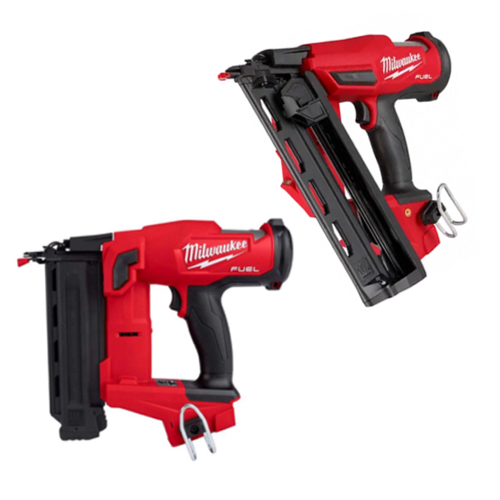
Wait, aren’t these the same thing? Uh…nope. What’s the different between a brad nailer vs finish nailer? So glad you asked! Let’s get into it because there are actually bigger differences between these two awesome tools that a lot of people don’t know.
Brad nailers and finish nailers are kissing cousins. They’re as similar as baseball and softball, which means they are NOT the same and not used for the same job even though the vast majority of DIYers and even tradesmen use them interchangeably.
Let me sum this post up simply so I don’t waste your time if you’re just looking for a quick answer:
A brad nailer shoots a small nail, which leaves a smaller nail hole to fill, but also has a weaker connection; whereas a finish nailer shoots a larger nail that provides a larger nail hole to fill, but a stronger connection.
What is a Brad Nailer?
A brad nailer is a tool that shoots small wire nails called brads. What the heck are brads? Brads are thin gauge metal nails best used for installing small pieces of wood trim where minimal nail filling is desired. Brad nailers are great for natural wood trim because they leave such a small nail hole that filling is often unnecessary.
Brad nailers are 18 ga. and can be found in both pneumatic (air powered) and battery models. 18 ga. brads are exclusively sold straight unlike finish nails which can be found in angled varieties.
A brad nailer is a great nailer for casual use where you’re not building large items or installing big moldings because their holding power is not terribly significant. Brad nails are typically available in sizes ranging from 1/2” to 2 1/2” long.
Strengths
- Small nail holes to fill
- Economical tool and brad costs
- Minimizes splitting wood
Weaknesses
- Nails bend easily
- Weaker holding strength
- Not good for hardwoods
What is a Finish Nailer?
Finish nailers are a larger category than brad nailers as there are multiple sizes and designs. The most common sizes are 16 ga. followed by 15 ga., and you buy them in both straight and angled versions. A finish nailer gets its name because it is most commonly used for finish carpentry. The lower the gauge number the thicker the nail, which gives it additional holding power.
Finish nailers excel at installing baseboards, crown molding, wainscoting, casing and other trim. The larger 15 ga. versions are actually strong enough to install door jambs and not just the trim.
There are a lot of things you can do with a finish nailer that you cannot, or at least should not, do with a brad nailer, and the only issue you are left with is that there is a larger nail hole to fill. Finish nails are typically available in sizes ranging from 1 1/4” to 2 1/2” long.
Strengths
- Extra versatile nailer
- Exceptional holding power
- Angled versions can fit in hard to reach areas
Weaknesses
- Higher tool and nail costs
- Larger holes to fill
- Can split small moldings
The Bottom Line
You’ve got the facts now, so here’s where I give you my thoughts as a regular user of all of these. I think that for most people having two nailers covers you so you can accomplish almost any task. For me that is an 18 ga. bra nailer and a 15 ga. finish nailer.
I like the power and security I get from using a 15 ga. nailer that unlike a 16 ga. version has nails that actually are not made from wire, but are actual nails. The holding power between the 16 and 15 ga. versions is surprisingly robust and the 15 ga. nails rarely bend or bind up like the 16 or 18 ga. versions. I can nail almost any hardwood and even old-growth woods with the 15 ga. nailer.
I use my brad nailer for pieces that don’t serve any structural purpose and won’t have any stresses on their strength like window stops, shoe molding, cove molding, quarter round or to hold something securely while the glue sets up in a joint.
Below is a quick reference to the thickness of the nails in each style nailer to give you a better sense of what kind of holding power you’ll get from the tool.
- 18 gauge: 0.0478 inch
- 16 gauge: 0.0598 inch
- 15 gauge: 0.0673 inch
Now you know the difference and can make an informed decision. Hopefully you’ll be better equipped for whatever projects you have coming up now being armed with the right tool for the right job.

Founder & Editor-in-Chief
I love old houses, working with my hands, and teaching others the excitment of doing it yourself! Everything is teachable if you only give it the chance.

